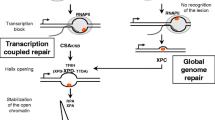Summary
A 1.75 kb DNA segment of the bacteriophage P1 genome is known to serve as a preferred target for IS2 insertions. The presence of this fragment in a plasmid expressing the galK gene dramatically increases the proportion of IS2 insertions among spontaneous galK - mutants. Subfragments from two different parts of the 1.75 kb segment independently stimulate IS2 insertion, while another subfragment does not. In the plasmids studied IS2 elements not only insert into the cloned P1 fragment but also into parts of the galK gene with similar probability and mostly in one orientation. Many insertion sites are unique but several specific sites within the preferred target are repeatedly used for IS2 integration. The experimental data are compatible with a proposed cooperative mechanism, according to which more than one attracting sequence on the same plasmid might significantly enhance the probability of a particular target region to attract IS2.
Similar content being viewed by others
References
Arber W, Sengstag C, Caspers P, Dalrymple B (1985) Evolutionary relevance of genetic rearrangements involving plasmids. In: Helinski DR, Cohen SN, Clewell DB, Jackson DA, Hollaender A (eds) Plasmids in Bacteria. Plenum Press, New York, pp 21–31
Birnboim HC, Doly J (1979) A rapid alkaline extraction procedure for screening recombinant plasmid DNA. Nucleic Acids Res 7:1513–1523
Caspers P, Dalrymple B, Iida S, Arber W (1984) IS30, a new insertion sequence of Escherichia coli K12. Mol Gen Genet 196:68–73
Debouck C, Riccio A, Schumperli D, McKenney K, Jeffers J, Hughes C, Rosenberg M (1985) Structure of the galactokinase gene of Escherichia coli, the last (?) gene of the gal operon. Nucleic Acids Res 13:1841–1853
Ghosal D, Saedler H (1977) Isolation of the mini insertions IS6 and IS7 of E. coli. Mol Gen Genet 158:123–128
Ghosal D, Sommer H, Saedler H (1979) Nucleotide sequence of the transposable DNA-element IS2. Nucleic Acids Res 6:1111–1122
Halling SM, Kleckner N (1982) A symmetrical six-base-pair target site sequence determines Tn10 insertion specificity. Cell 28:155–163
Holmes DS, Quigley M (1981) A rapid boiling method for the preparation of bacterial plasmids. Anal Biochem 114:193–197
Iida S, Meyer J, Bächi B, Stalhammar-Carlemalm M, Schrickel S, Bickle TA, Arber W (1983) DNA restriction-modification genes of phage P1 and plasmid p15B. J Mol Biol 165:1–18
Klaer R, Kühn S, Fritz HJ, Tillmann E, Saint-Girons I, Habermann P, Pfeifer D, Starlinger P (1980) Studies on transposition mechanisms and specificity of IS4. Cold Spring Harbor Symp Quant Biol 45:215–224
Maniatis T, Jeffrey A, Kleid DR (1975) Nucleotide sequence of the rightward operator of phage λ. Proc Natl Acad Sci USA 72:1184–1188
McKenney K, Shimatake H, Court D, Schmeissner U, Brady C, Rosenberg M (1981) A system to study promoter and terminator signals recognized by Escherichia coli RNA polymerase. In: Chirikjian JG, Papas TS (eds) Gene amplification and analysis, vol. 2. Elsevier, New York, pp 383–415
Meyer J, Iida S, Arber W (1983) Physical analysis of the genomes of hybrid phages between phage P1 and plasmid p15B. J Mol Biol 165:191–195
Nikaido H (1961) Galactose sensitive mutants of Salmonella. I. Metabolism of galactose. Biochim Biophys Acta 48:460–469
Remaut E, Tsao H, Fiers W (1983) Improved plasmid vectors with a thermoinducible expression and temperature-regulated runaway replication. Gene 22:103–113
Saint-Girons I, Fritz HJ, Shaw C, Tillmann E, Starlinger P (1981) Integration specificity of an artificial transposon constructed by the in vitro insertion of an internal Tn5 fragment into IS2. Mol Gen Genet 183:45–50
Sengstag C, Arber W (1983) IS2 insertion is a major cause of spontaneous mutagenesis of the bacteriophage P1: non-random distribution of target sites. EMBO J 2:67–71
Sengstag C, Shepherd JCW, Arber W (1983) The sequence of the bacteriophage P1 genome region serving as hot target for IS2 insertion. EMBO J 2:1777–1781
Smith GE, Summers MD (1980) The bidirectional transfer of DNA and RNA to nitrocellulose or diazobenzyloxymethyl-paper. Anal Biochem 109:123–129
Walker D, Walker JT (1976) Genetic studies of coliphage P1. III. Extended genetic map. J Virol 20:177–187
Weinert TA, Schaus NA, Grindley NDF (1983) Insertion sequence duplication in transpositional recombination. Science 222:755–765
Yarmolinsky M (1982) Bacteriophage P1. In: O'Brien SJ (ed) Genetic maps, vol. 2. National Cancer Institute, Frederick, Maryland, pp 34–43
Author information
Authors and Affiliations
Additional information
Communicated by J.W. Lengeler
Rights and permissions
About this article
Cite this article
Sengstag, C., Arber, W. A cloned DNA fragment from bacteriophage P1 enhances IS2 insertion. Mol Gen Genet 206, 344–351 (1987). https://doi.org/10.1007/BF00333593
Received:
Issue Date:
DOI: https://doi.org/10.1007/BF00333593




